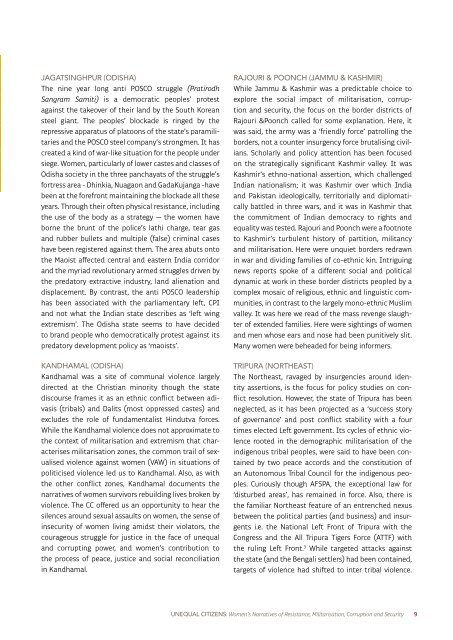CC_India
CC_India
CC_India
Create successful ePaper yourself
Turn your PDF publications into a flip-book with our unique Google optimized e-Paper software.
JAGATSINGHPUR (ODISHA)<br />
The nine year long anti POSCO struggle (Pratirodh<br />
Sangram Samiti) is a democratic peoples’ protest<br />
against the takeover of their land by the South Korean<br />
steel giant. The peoples’ blockade is ringed by the<br />
repressive apparatus of platoons of the state’s paramilitaries<br />
and the POSCO steel company’s strongmen. It has<br />
created a kind of war-like situation for the people under<br />
siege. Women, particularly of lower castes and classes of<br />
Odisha society in the three panchayats of the struggle’s<br />
fortress area - Dhinkia, Nuagaon and GadaKujanga -have<br />
been at the forefront maintaining the blockade all these<br />
years. Through their often physical resistance, including<br />
the use of the body as a strategy — the women have<br />
borne the brunt of the police’s lathi charge, tear gas<br />
and rubber bullets and multiple (false) criminal cases<br />
have been registered against them. The area abuts onto<br />
the Maoist affected central and eastern <strong>India</strong> corridor<br />
and the myriad revolutionary armed struggles driven by<br />
the predatory extractive industry, land alienation and<br />
displacement. By contrast, the anti POSCO leadership<br />
has been associated with the parliamentary left, CPI<br />
and not what the <strong>India</strong>n state describes as ‘left wing<br />
extremism’. The Odisha state seems to have decided<br />
to brand people who democratically protest against its<br />
predatory development policy as ‘maoists’.<br />
KANDHAMAL (ODISHA)<br />
Kandhamal was a site of communal violence largely<br />
directed at the Christian minority though the state<br />
discourse frames it as an ethnic conflict between adivasis<br />
(tribals) and Dalits (most oppressed castes) and<br />
excludes the role of fundamentalist Hindutva forces.<br />
While the Kandhamal violence does not approximate to<br />
the context of militarisation and extremism that characterises<br />
militarisation zones, the common trail of sexualised<br />
violence against women (VAW) in situations of<br />
politicised violence led us to Kandhamal. Also, as with<br />
the other conflict zones, Kandhamal documents the<br />
narratives of women survivors rebuilding lives broken by<br />
violence. The <strong>CC</strong> offered us an opportunity to hear the<br />
silences around sexual assaults on women, the sense of<br />
insecurity of women living amidst their violators, the<br />
courageous struggle for justice in the face of unequal<br />
and corrupting power, and women’s contribution to<br />
the process of peace, justice and social reconciliation<br />
in Kandhamal.<br />
RAJOURI & POONCH (JAMMU & KASHMIR)<br />
While Jammu & Kashmir was a predictable choice to<br />
explore the social impact of militarisation, corruption<br />
and security, the focus on the border districts of<br />
Rajouri &Poonch called for some explanation. Here, it<br />
was said, the army was a ‘friendly force’ patrolling the<br />
borders, not a counter insurgency force brutalising civilians.<br />
Scholarly and policy attention has been focused<br />
on the strategically significant Kashmir valley. It was<br />
Kashmir’s ethno-national assertion, which challenged<br />
<strong>India</strong>n nationalism; it was Kashmir over which <strong>India</strong><br />
and Pakistan ideologically, territorially and diplomatically<br />
battled in three wars, and it was in Kashmir that<br />
the commitment of <strong>India</strong>n democracy to rights and<br />
equality was tested. Rajouri and Poonch were a footnote<br />
to Kashmir’s turbulent history of partition, militancy<br />
and militarisation. Here were unquiet borders redrawn<br />
in war and dividing families of co-ethnic kin. Intriguing<br />
news reports spoke of a different social and political<br />
dynamic at work in these border districts peopled by a<br />
complex mosaic of religious, ethnic and linguistic communities,<br />
in contrast to the largely mono-ethnic Muslim<br />
valley. It was here we read of the mass revenge slaughter<br />
of extended families. Here were sightings of women<br />
and men whose ears and nose had been punitively slit.<br />
Many women were beheaded for being informers.<br />
TRIPURA (NORTHEAST)<br />
The Northeast, ravaged by insurgencies around identity<br />
assertions, is the focus for policy studies on conflict<br />
resolution. However, the state of Tripura has been<br />
neglected, as it has been projected as a ‘success story<br />
of governance’ and post conflict stability with a four<br />
times elected Left government. Its cycles of ethnic violence<br />
rooted in the demographic militarisation of the<br />
indigenous tribal peoples, were said to have been contained<br />
by two peace accords and the constitution of<br />
an Autonomous Tribal Council for the indigenous peoples.<br />
Curiously though AFSPA, the exceptional law for<br />
‘disturbed areas’, has remained in force. Also, there is<br />
the familiar Northeast feature of an entrenched nexus<br />
between the political parties (and business) and insurgents<br />
i.e. the National Left Front of Tripura with the<br />
Congress and the All Tripura Tigers Force (ATTF) with<br />
the ruling Left Front. 3 While targeted attacks against<br />
the state (and the Bengali settlers) had been contained,<br />
targets of violence had shifted to inter tribal violence.<br />
UNEQUAL CITIZENS: Women’s Narratives of Resistance, Militarisation, Corruption and Security<br />
9


